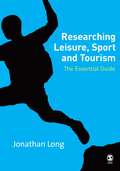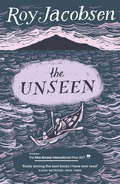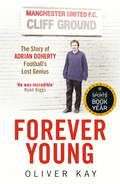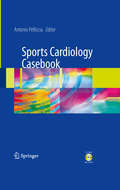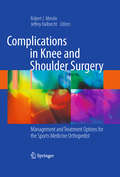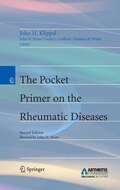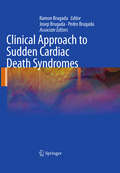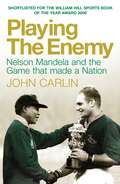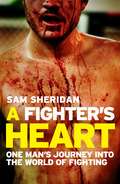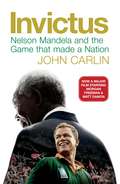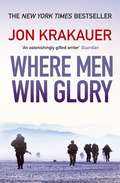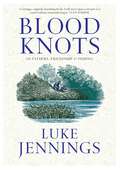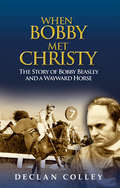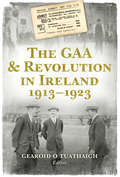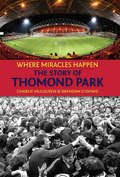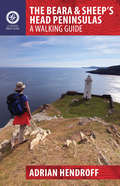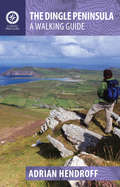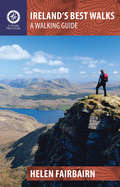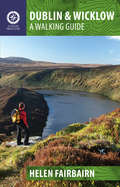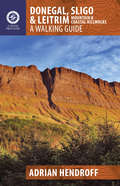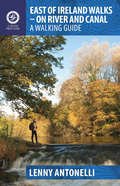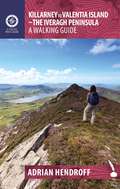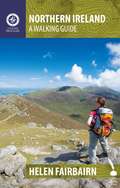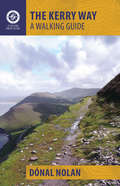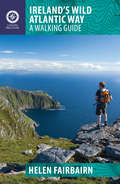- Table View
- List View
Researching Leisure, Sport and Tourism: the Essential Guide (PDF)
by Jonathan LongWhat are the essential research methods for students studying leisure, sport and tourism? What are the main benefits in competing research methods, and how can you avoid gremlins in the research process? This is a comprehensive and informative book written especially for new and inexperienced researchers in the fields of leisure, sport and tourism, both full-time students and people in employment having to conduct their own research or make use of other people's research.
The Unseen: SHORTLISTED FOR THE MAN BOOKER INTERNATIONAL PRIZE 2017
by Roy JacobsenShortlisted for the Man Booker International Prize 2017Nobody can leave an island. An island is a cosmos in a nutshell, where the stars slumber in the grass beneath the snow. But occasionally someone tries . . . Ingrid Barrøy is born on an island that bears her name - a holdfast for a single family, their livestock, their crops, their hopes and dreams.Her father dreams of building a quay that will connect them to the mainland, but closer ties to the wider world come at a price. Her mother has her own dreams - more children, a smaller island, a different life - and there is one question Ingrid must never ask her.Island life is hard, a living scratched from the dirt or trawled from the sea, so when Ingrid comes of age, she is sent to the mainland to work for one of the wealthy families on the coast.But Norway too is waking up to a wider world, a modern world that is capricious and can be cruel. Tragedy strikes, and Ingrid must fight to protect the home she thought she had left behind.Translated from the Norwegian by Don Bartlett and Don Shaw
Forever Young: The Story of Adrian Doherty, Football's Lost Genius
by Oliver KayWINNER OF THE FOOTBALL BOOK OF THE YEAR AT THE BRITISH SPORTS BOOK AWARDSSHORTLISTED FOR THE 2016 WILLIAM HILL SPORTS BOOK OF THE YEAR'This football book is about something even more important than the "beautiful game"; it is a story of the human spirit.' - Mick Hume, The Times Adrian Doherty was not a typical footballer. For one thing, he was blessed with extraordinary talent. Those who played alongside and watched him in the Manchester United youth team in the early 1990s insist he was as good as Ryan Giggs - possibly even better. Giggs, who played on the opposite wing, says he is inclined to agree.Doherty was also an eccentric - by football standards, at least. When his colleagues went to Old Trafford to watch the first team on Saturday afternoons, he preferred to take the bus into Manchester to go busking. He wore second-hand clothes, worshipped Bob Dylan, read about theology and French existentialism and wrote songs and poems. One team-mate says "it was like having Bob Dylan in a No 7 shirt".On his 17th birthday, Doherty was offered a five-year contract - unprecedented for a United youngster at that time - and told by Alex Ferguson that he was destined for stardom. But what followed over the next decade is a tale so mysterious, so shocking, so unusual, so amusing but ultimately so tragic, that you are left wondering how on earth it has been untold for so long.The stories of Doherty's contemporaries, that group of Manchester United youngsters who became known as the "Class of '92", are well known. Giggs ended up as the most decorated player in United's history; David Beckham became the most recognisable footballer on the planet; Gary Neville, Paul Scholes and others are household names. The story you don't know is about the player who, having had the world at his feet, died the day before his 27th birthday following an accident in a canal in Holland.
Sports Cardiology Casebook
by Antonio PellicciaComparatively little is known about the risk of sudden death associated with exercise in young competitive athletes, and whether the benefits of sports activity outweigh the hazards of exercise-related fatal events is a clinical dilemma. This is only a small part of the story, however, as there are considerable effects of exercise whether it be at a competitive level or on a ‘leisure’ level on patients of all ages. This in itself is of massive importance to the cardiac patient population as exercise is a key component of effective recovery and recommended as central in the prevention of much cardiac disease.
Complications in Knee and Shoulder Surgery: Management and Treatment Options for the Sports Medicine Orthopedist
by Robert J. Meislin Jeffrey Halbrecht“To Err is Human…” Alexander Pope Any surgical intervention has potential risks and complications. This book is designed as a reference tool and a roadmap for the sports medicine orthopedist to minimize the complications in knee and shoulder surgery. Some complications are avoidable; some are not. By understanding the functional anatomy at risk, proper surgical setup, proper equipment, and proper patient selection, a preventative approach to complications can be instituted. The authors of these chapters represent leaders in orthopedic sports medicine and have provided novel methods for dealing with intraoperative complications and si- ations that can occur in the midst of a “routine” arthroscopic reconstruction. In d- cussing these issues, we hope to raise the surgeon’s awareness of potential complications and to provide wisdom and advice to properly avoid and treat these problems should they arise. How one deals with complications truly tests the mettle of the surgeon. Keeping one’s “cool” in the midst of an intraoperative complication will be facilitated by h- ing an algorithmic approach. We hope that this book will improve your outcome should these problems occur. Some complications are unavoidable. Arthro brosis or stiffness may take place in the best of hands. Infection may surface postoperatively in the most sterile OR. We provide you with the background to confront these challenges. A list of ten “Pearls” are offered at the beginning of most chapters as a quick reference card.
Pocket Primer on the Rheumatic Diseases
by John H. Stone Leslie J. Crofford Patience H. WhiteFor eight decades the Primer on the Rheumatic Diseases has been the standard text from which most medical students and house ofcers have learned rheumatology. I myself will never forget thumbing through an older edition of the Primer as a second-year resident, while waiting to review a perplexing patient with my tutor. Fortunately the tutor was r- ning late with his own patients, so I had time to fip through the book – then much thinner – a couple of times. While turning the pages, per- ing the features of those diseases whose names were still exotic to me, and considering my patient’s history of conductive hearing loss and p- monary nodules, a light went on when I stumbled eventually on a part- ular chapter. I still remember the jaw-dropping efect on my tutor of my announcement then that I had a patient with Wegener’s granulomatosis. I think I became a rheumatologist that very moment! Subsequent editions of the Primer have sufered from the inevitable “obesity creep,” making it an outstanding reference textbook but virtually impossible to fip through quickly while awaiting one’s tutor, and even more difcult to slip into the pocket of a white coat to carry on rounds. For this reason we have created the Pocket Primer, a mini version that cuts the larger book down to its essentials.
Clinical Approach to Sudden Cardiac Death Syndromes
by Josep Brugada Pedro BrugadaClinical cardiologists are encountering an important challenge in the caring of families with inherited cardiac diseases. The majority of the inherited cardiac diseases causing sudden death express themselves at variable ages in the form of altered muscle function (i.e hypertrophic or dilated cardiomyopathy) or in the form of arrhythmias (i.e. Brugada syndrome, long QT syndrome). However, it is not uncommon that the first sign of the disease may actually be sudden cardiac death, even before the identification of clear clinical abnormalities. In this last decade, with more than 50 new disease-associated genes identified, the possibility of genetic testing has opened a new opportunity to disease diagnosis and prevention. Clinical and genetic research is continuously on-going not only to identify those at risk, but to better define their level or risk still with limited success.
Playing the Enemy: Nelson Mandela and the Game That Made a Nation
by John CarlinNow filmed as INVICTUS directed by Clint Eastwood, and starring Matt Damon and Morgan Freeman as Nelson Mandela. SHORTLISTED FOR THE WILLIAM HILL SPORTS BOOK OF THE YEAR 2008As the day of the final of the 1995 Rugby World Cup dawned, and the Springboks faced New Zealand's all-conquering All Blacks, more was at stake than a sporting trophy. When Nelson Mandela appeared wearing a Springboks jersey and led the all-white Afrikaner-dominated team in singing South Africa's new national anthem, he conquered the hearts of white South Africa. Playing the Enemy tells the extraordinary human story of how that moment became possible. It shows how a sport, once the preserve of South Africa's Afrikaans-speaking minority, came to unify the new rainbow nation, and tells of how - just occasionally - something as simple as a game really can help people to rise above themselves and see beyond their differences.
A Fighter's Heart: One man's journey through the world of fighting
by Sam SheridanAfter a series of adventurous jobs around the world, Sam Sheridan found himself in Australia, cash-rich and with time on his hands to spend it. It occurred to him that he could finally explore a long-held obsession: fighting. Within a year, he was in Bangkok training with Thailand's greatest kickboxing champion and stepping through the ropes for his first professional bout. But one fight wasn't enough, and Sheridan set out to test himself on an epic journey into how and why we fight, facing Olympic boxers, Brazilian jiu-jitsu stars, and Ultimate Fighting champions.
Invictus: Nelson Mandela and the Game That Made a Nation
by John CarlinThis uplifting true story is now a major film, starring Oscar nominees Morgan Freeman and Matt Damon, directed by Clint Eastwood.Shortlisted for the William Hill Sports Book of the Year 2008As the day of the final of the 1995 Rugby World Cup dawned, and the Springboks faced New Zealand's all-conquering All Blacks, more was at stake than a sporting trophy. When Nelson Mandela appeared wearing a Springboks jersey and led the all-white Afrikaner-dominated team in singing South Africa's new national anthem, he conquered the hearts of white South Africa. Invictus tells the extraordinary human story of how that moment became possible. It shows how a sport, once the preserve of South Africa's Afrikaans-speaking minority, came to unify the new rainbow nation, and tells of how - just occasionally - something as simple as a game can help people to rise above themselves and see beyond their differences.
Where Men Win Glory: The Odyssey of Pat Tillman
by Jon KrakauerPat Tillman was well-known to American sports fans: a chisel-jawed and talented young professional football star, he was on the brink of signing a million dollar contract when, in 2001, al-Qaeda launched terrorist attacks against his country. Driven by deeply felt moral patriotism, he walked away from fame and money to enlist in the United States Special Operations Forces. A year later he was killed - apparently in the line of fire - on a desolate hillside near the Pakistan border in Afghanistan. News of Tillman's death shocked America. But even as the public mourned his loss, the US Army aggressively maneuvered to conceal the truth: that it was a ranger in Tillman's own platoon who had fired the fatal shots. In Where Men Win Glory, Jon Krakauer reveals how an entire country was deliberately deceived by those at the very highest levels of the US army and government. Infused with the power and authenticity readers have come to expect from Krakauer's storytelling, Where Men Win Glory exposes shattering truths about men and war.
Blood Knots: Of Fathers, Friendship and Fishing
by Luke JenningsSHORTLISTED FOR THE 2010 BBC SAMUEL JOHNSON PRIZESHORTLISTED FOR THE 2010 WILLIAM HILL SPORTS BOOK OF YEARAs a child in the 1960s, Luke Jennings was fascinated by the rivers and lakes around his Sussex home. Beneath their surfaces, it seemed to him, waited alien and mysterious worlds. With library books as his guide, he applied himself to the task of learning to fish. His progress was slow, and for years he caught nothing. But then a series of teachers presented themselves, including an inspirational young intelligence officer, from whom he learnt stealth, deception and the art of the dry fly. So began an enlightening but often dark-shadowed journey of discovery. It would lead to bright streams and wild country, but would end with his mentor's capture, torture and execution by the IRA. Blood Knots is about angling, about great fish caught and lost, but it is also about friendship, honour and coming of age. As an adult Jennings has sought out lost and secretive waterways, probing waters 'as deep as England' at dead of night in search of giant pike. The quest, as always, is for more than the living quarry. For only by searching far beneath the surface, Jennings suggests in this most moving and thought-provoking of memoirs, can you connect with your own deep history.
When Bobby Met Christy: The Story Of Bobby Beasley And A Wayward Horse
by Declan ColleyBobby Beasley was a champion jockey. By 26, he had won a Cheltenham Gold Cup, a Champion Hurdle and a Grand National. But when he was 24, Bobby took his first drink and soon succumbed to alcoholism. He turned a corner after his friend, Nicky Rackard, urged him to attend Alcoholics Anonymous. Five years later, aged 38, Beasley rode Captain Christy to an amazing victory at the Cheltenham Gold Cup. In the history of unlikely comebacks, that of Irish jockey Bobby Beasley is the most heartwarming of them all.
The GAA and Revolution in Ireland 1913–1923
by Gearóid Ó TuathaighThe decade between the labour conflict (the ‘Lockout’) of 1913 and the end of the Civil War in 1923 was one of seismic upheaval. How the GAA – a major sporting and national body – both influenced and was influenced by this upheaval is a rich and multifaceted story. Leading writers in the field of modern Irish history and the history of sport explore the impact on ‘ordinary’ life of major events. They examine the effect of the First World War, the 1916 Rising and its aftermath, the emergence of nationalist Sinn Féin and its triumph over the Irish Parliamentary Party, as well as the War of Independence (1919–21) and the bitter Civil War (1922–23). This is an original and engrossing perspective through the lens of a sporting organisation. Contributors: Eoghan Corry, Mike Cronin, Paul Darby, Páraic Duffy, Diarmaid Ferriter, Dónal McAnallen, James McConnel, Richard McElligott, Cormac Moore, Seán Moran, Ross O’Carroll, Gearóid Ó Tuathaigh, Mark Reynolds, Paul Rouse
The Story of Thomond Park: Where Miracles Happen
by Charlie Mulqueen Brendan O'Dowd‘What’s so special about Thomond Park? The crowd. Simply the crowd. The atmosphere is electric.’ Donal Spring, one of Munster rugby’s greatest. Since the first game played there in 1934, Thomond Park has become one of the world’s iconic rugby venues. It is a magnificent stadium, famous for many great occasions, notably Munster’s 1978 victory over the All Blacks and the ‘Miracle Match’ against Gloucester in 2003. It also has a worldwide reputation for tradition, wit and an outstanding sense of fair play. Here the history of Thomond Park is traced in a colourful and entertaining style, featuring some rare photos of Munster favourite Paul O’Connell, and highlighting great games played and great characters who have graced the arena.
The Beara & Sheep's Head Peninsulas: A Walking Guide (A Walking Guide)
by Adrian HendroffThe Beara and Sheep’s Head Peninsulas, in the southwest of Ireland, are both unspoilt and hold some of Ireland’s most beautiful scenery. These routes range from short hikes to longer treks, coastal and inland, something to suit everyone’s interest. Stroll the woodland and mountain trails of Gougane Barra or take on Hungry Hill for a more challenging hillwalk, with lots more in between. There is no better way to explore this landscape than on foot. * For a complete list of walking guides available from The Collins Press, see www.collinspress.ie
The Dingle Peninsula: A Walking Guide (A Walking Guide)
by Adrian HendroffThe spectacular Dingle Peninsula in southwest Ireland extends westward into the Atlantic from Tralee to Slea Head. Voted among the Top 100 destinations in the world by TripAdvisor and referred to as ‘the most beautiful place on earth’ by National Geographic, its landscape includes soaring mountaintops, gentle hillsides, secluded lakes and valleys, ancient ruins, dramatic sea cliffs and long, sandy beaches. This guide takes you off the beaten track to explore this stunning landscape in a variety of walking routes ranging from short hikes to full-day treks. From the wild extremities of the Great Blasket Island to the majestic heights of Mount Brandon and the comfort of the Dingle Way, there’s something for all tastes. Each route is prefaced with a reference summary and illustrated with maps and photographs. Route descriptions include GPS coordinates, navigation guidance, access notes and short variations. There is also material on the fauna, flora, folklore, history, geology and place names of each area. * For a complete list of walking guides available from The Collins Press, see www.collinspress.ie
Ireland's Best Walks: A Walking Guide (A Walking Guide)
by Helen FairbairnIn a country richly endowed with wild mountain ranges, secluded valleys and untamed coastlines, the best natural landscapes can only be explored on foot. Here are over sixty of the greatest one-day walking routes in Ireland, varying from short strolls to full-day treks. Every part of the Republic and Northern Ireland is featured. From rugged peaks and chiselled ridge lines to towering sea cliffs and sheltered loughs, these routes take you past all the country’s finest scenery. Many of the routes are hill-walks, with clear descriptions of the country’s classic mountain ascents. Even seasoned hillwalkers will find challenging outings. Each walk is illustrated with sketch maps and colour photos and is prefaced with a quick-reference summary and access notes. Route descriptions include clear navigational guidance to keep you on the right track.
Dublin & Wicklow: A Walking Guide (A Walking Guide)
by Helen Fairbairnl show you the way! • Also by this author: 'Northern Ireland: A Walking Guide'. For a complete list of walking guides available from The Collins Press, see www.collinspress.ie
Donegal, Sligo & Leitrim: A Walking Guide (A Walking Guide)
by Adrian HendroffThe northwest of Ireland provides a diversity of walks, from the wild, untamed landscape of Donegal to the gentler hills and green valleys of Sligo and Leitrim. This guidebook describes 27 walks of various grades, accompanied by quality photographs and specially drawn maps. Walk descriptions also include material on the rich natural history, folklore, geology and place names of the area. Since most routes are not signposted or waymarked, an up-to-date guidebook is essential. This will inspire you to get your walking boots on and start exploring this majestic landscape. • Also by this author: 'The Dingle Peninsula: A Walking Guide' and 'The Beara & Sheep's Head Peninsulas: A Walking Guide'. For a complete list of walking guides available from The Collins Press, see www.collinspress.ie
East of Ireland Walks: On River And Canal (A Walking Guide)
by Lenny AntonelliRiver and canal walks can have special appeal, the scenery always changing due to flowing water, weirs, locks and the changing countryside. Ireland's rivers and canals are rich in wildlife, history and folklore, and many can be explored on mostly flat, little-used trails. These hidden corridors of wildness through rural and urban Ireland reveal remnants of a time when trade, transport and industry in Ireland revolved around water rather than roads. Lenny Antonelli introduces some of the best river and canal trails in the east and east midlands, from short strolls to a five-day trek along the Barrow. These walks encompass iconic Irish rivers such as the Liffey, the Boyne and the Nore; and waterways such as the Grand and Royal Canals. There are lesser-known trails here too, from ravines in the Slieve Bloom Mountains to the young rivers of Wicklow’s deep wooded valleys. For those new to walking, these trails form easy introductions. For experienced walkers, they provide new and less-trodden paths through places of unexpected beauty. • Also available: 'Dublin & Wicklow: A Walking Guide' by Helen Fairbairn
Killarney to Valentia Island: A Walking Guide (A Walking Guide)
by Adrian HendroffThe Iveragh Peninsula, the largest in southwest Ireland, stretches from Killarney to Bolus Head and attracts thousands of visitors annually. The Ring of Kerry coastal road winds along its fringes and sandstone peaks soar high above. It is a landscape of raw and stunning beauty from the lakes that fill the corries to the spectacular cliff scenery along its coast. There is no better way to explore this landscape than on foot. This book helps you do just that with routes ranging from a few hours to full-day walks. Explore Valentia Island, the majestic MacGillycuddy’s Reeks and sections of The Kerry Way. Go off the beaten track and explore the coast, hills and woodlands from Killarney to Cahersiveen to Kenmare. Each route is prefaced with a reference summary and illustrated with maps and photographs. Route descriptions include GPS coordinates, navigation guidance, access notes and short variations. There is also material on the fauna, flora, folklore, history, geology and place names of each area.
Northern Ireland: A Walking Guide (A Walking Guide)
by Helen FairbairnThis revised guide presents top-class walking routes in Northern Ireland. From rugged mountain peaks to spectacular coastal scenery, from challenging hill walks to shorter woodland and waterside excursions, there is something for everyone. Every part of the region is covered, from the mountains of Mourne to the Giant’s Causeway, from Fermanagh’s ‘lake district’ to the rolling Sperrins. Routes vary from two-hour strolls to eight-hour upland challenges. Much thought has gone into making this guide easy to use: each route, prefaced with a quick-reference summary, is illustrated with a clear sketch map; descriptions include detailed access information while points of interest are highlighted – flora and fauna, history, archaeology and folklore. A compact region with huge scenic variety, Northern Ireland is ideal for walking yet is often overlooked. This authoritative guide is changing that, using the author’s enthusiasm and knowledge.
The Kerry Way: A Walking Guide (A Walking Guide)
by Donal NolanThe Kerry Way is Ireland’s longest waymarked trail and one of the most popular. Looping around the Iveragh Peninsula, it follows narrow country roads, forest paths, abandoned coach roads and mass paths, national park land and farmland. This clear and lively guide gives the prospective wayfarer enough information to plan and enjoy every step. It offers a detailed description of the trail plus lively asides on geology, history, folklore, settlement, flora and fauna. Above all, this guide will keep the reader from getting lost. The trail description is broken down into sections from the first step out of Killarney, through the high passes in the MacGillycuddy’s Reeks, into the splendour of the Ring of Kerry, and back to Killarney. This guidebook is a light, lively guide to this 200km walk, with enough guidance, cultural background and natural history to ensure the user stays on trackto arrive at their car, hostel or B&B. Also available: 'Killarney to Valentia Island – The Iveragh Peninsula: A Walking Guide' and 'The Dingle Peninsula: A Walking Guide'
Ireland's Wild Atlantic Way: A Walking Guide (A Walking Guide)
by Helen FairbairnThe Wild Atlantic Way follows the magnificent west coast of Ireland, passing golden beaches, thrusting headlands and soaring sea cliffs. Renowned walking-guide author Helen Fairbairn explores the best walking routes of the region, recommending trips to uninhabited islands, coastal mountains and much more. Routes vary from two to six hours, and are illustrated with colour photos and detailed maps. Whatever your level of expertise, this comprehensive guide is all you need to discover the real wonders of the Wild Atlantic Way. Praise for this author: ‘Handy, easy to use guide.’ Walking World Ireland. ‘Will be appreciated by local walkers and visitors alike.’ Irish Mountain Log. ‘Ideal for bringing out on a trail.’ The Irish Times Also by this author: ‘Dublin & Wicklow: A Walking Guide’, ‘Ireland’s Best Walks: A Walking Guide’, ‘Northern Ireland: A Walking Guide’
